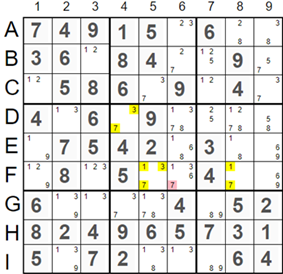
Three cells, D4, F5, and F8, have possible values of
'1',
'3', and
'7' marked in yellow. Cell F5 acts as a hinge, containing all three numbers and linking to both D4 and F8. This is because F5 shares the same row with F8 and the same square with D4. Cell F6 is connected to all three of these cells; it is in the same row as F7 and in the same square as F5 and D4. In any scenario, at least one of the cells D4, F5, or F8 must have a value of 7. Therefore, any cell linked to all three of these cells should not have a value of 7. Consequently, we can remove the hint of
'7' (marked in red) from cell F6.